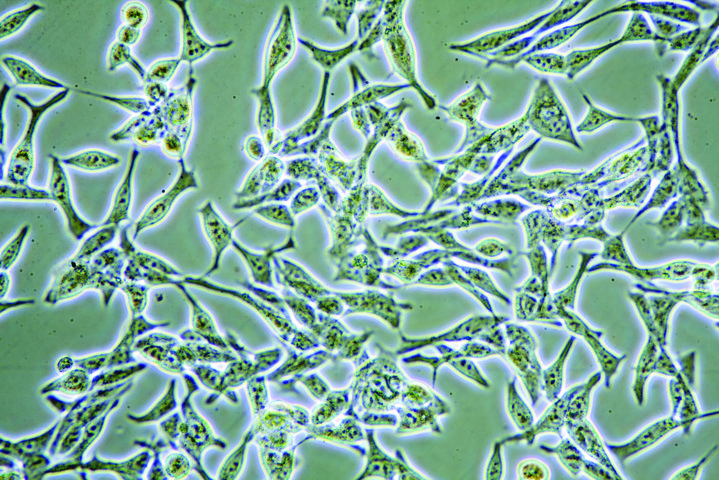Professor Ian A. Blair – Of Metabolites and Men: Applications of Metabolomics to Medicine
Diseases are often characterised with a distinctive chemical spectral ‘fingerprint’ that reflects the profound metabolic changes brought on by disease pathogenesis. Professor Ian Blair and his team at the University of Pennsylvania use the emerging science of ‘metabolomics’ to elucidate the mechanisms that cause disease, develop biomarkers and investigate therapeutic approaches that target the metabolism of abnormal cells.
Over the past decade, there has been much progress in the development of metabolomics, one of the key ‘omics’ sciences (along with genomics, proteomics, transcriptomics and others), that are revolutionising biology and medicine. Metabolomics uses cutting-edge analytical chemistry techniques to characterise repertoires of small molecules present in cells and tissues, known as metabolites. Metabolism – the vast, complex network of chemical reactions that occurs within living systems – involves the conversion of thousands of metabolites, each reaction being catalysed by specific enzymes. This vital web of metabolic pathways is what keeps us alive, although occasionally things go wrong, and the promotion or inhibition of certain pathways can result in disease. Elucidating the metabolic basis of disease states has become a lively field of study over the past few decades. In particular, the ‘metabolic reprogramming’ that occurs in cancer has been implicated in disease pathogenesis and progression.
While metabolomics may be considered a posterchild of 21st century science, its roots are historic. Over a century ago, Sir Archibald Garrod (1857–1936), a British physician, was the first to link metabolism with disease, and coined the term ‘inborn errors of metabolism’, based on his studies on alkaptonuria (black urine disease). Since then, a plethora of analytical methods and computational tools have emerged to characterise the vast array of metabolites in biological tissues. The three major workhorses of modern metabolomics that have developed in the last 15 years are nuclear magnetic resonance (NMR) spectroscopy, gas chromatography mass spectrometry (GC-MS) and liquid chromatography MS (LC-MS). NMR discriminates between metabolites’ proton resonance spectra, whereas mass spectrometry differentiates qualitatively based on metabolites’ size and structure. Appropriate validation and quality control samples are needed to provide adequate rigor. Other technologies commonly used include magnetic resonance spectroscopy (MRS), positron emission tomography (PET), matrix-assisted laser desorption/ionisation (MALDI)-MS, secondary ion MS (SIMS) and desorption electrospray ionisation MS (DESI-MS) techniques.
 Professor Ian Blair of the University of Pennsylvania is an eminent authority within the emerging field of metabolomics. His research group focuses on the development of metabolomics methodologies, for biomarker analysis and validation, probing the metabolic basis of a number of diseases, particularly cancer, and investigating the impact of drug candidates on target pathways.
Professor Ian Blair of the University of Pennsylvania is an eminent authority within the emerging field of metabolomics. His research group focuses on the development of metabolomics methodologies, for biomarker analysis and validation, probing the metabolic basis of a number of diseases, particularly cancer, and investigating the impact of drug candidates on target pathways.
Biomarker Analysis and Validation
A major component of metabolomics research is the analysis of low molecular weight biomarkers. Biomarkers are chemical, physical or physiological indicators of a disease that can be detected and quantified for disease diagnosis and prognosis and to inform treatment. Robust biomarkers are needed for effective screening, surveillance and primary prevention of disease states. Biomarkers can be molecular such as proteins, carbohydrates, small molecule metabolites, or genetic, such as gene variants (alleles) or mutations that indicate the presence and severity of a disease.
The use of protein biomarkers has been developed in recent years, though these are sometimes inadequate. For instance, serum prostate antigen (PSA) – the standard biomarker for monitoring prostate cancer treatment – is notorious for having low specificity and sensitivity. In fact, its use in prostate cancer screening is controversial and not recommended. Likewise, no clinically useful biomarkers exist for colorectal cancer, with colonoscopies being standard for diagnosis. Similarly, for pancreatic cancer, the most useful biomarker, CA19–5 antigen found in sera, is also elevated in non-malignant jaundice and liver cirrhosis. While protein-based biomarkers are commonly used for cancer screening and surveillance, the presence of these proteins in non-diseased states and other conditions compromises sensitivity and specificity. In contrast, metabolite spectral ‘fingerprints’ tend to be unique to a disease state. There is increasing interest in the use of metabolomics-based biomarkers for disease states. Professor Blair’s group is developing and validating methods for analysis of oestrogens in the sera of postmenopausal women using liquid chromatography-tandem mass spectrometry (LC-MS/MS), as an early-stage biomarker of breast cancer risk.

A major part of Professor Blair’s focus is the development of metabolic biomarkers for diseases. One such disease that his team are studying is Friedreich’s ataxia, a recessive inherited disease that causes progressive damage to the nervous system. Friedreich’s ataxia is caused by a mutation in frataxin, a small protein required for iron-sulphur protein cluster protein assembly in the mitochondria. Unfortunately, the inability to access the highly affected neuronal and cardiac tissues has hampered metabolic evaluation and biomarker development. As a metabolic biomarker, the team developed a metabolic assay based on incorporating 13C labelled glucose into acetyl-CoA and succinyl CoA, metabolites used in the TCA cycle, in patient-derived platelets. Successful incorporation is indicative of functional aconitase, an iron-sulphur cluster-based enzyme, which requires functional frataxin to work.
The selection of in vivo cells or tissues for metabolomics analysis is important. A wide variety of biological specimens have been used including urine, faeces, blood, saliva, cerebrospinal fluid and exhaled breath condensate. Biological samples are fairly messy and often need to be ‘cleaned’ prior to MS or NMR.
Mitochondrial Dysfunction in Diseases and Therapeutic Approaches
As well as using metabolomics for disease diagnosis, Professor Blair’s research group also targets metabolism for disease therapy, especially for cancer. Tumour cells are known to have altered metabolism compared to healthy cells. Respiration, the metabolic ‘burning’ of food molecules to release vital energy is an essential feature of all living cells, including diseased and tumour cells. A particular focus of Professor Blair’s team is targeting respiration in abnormal cells, either for disease therapy or to gain mechanistic insights into the respiratory aberrations that are often part of disease pathogenesis, particularly in cancer and neuronal defects. Moreover, fast-growing tumour cells usually have high respiratory activities and lactate accumulation due to high levels of inefficient anaerobic respiration based on glycolysis (the so-called ‘Warburg Effect’).

A brief explanation of respiration is necessary here. Sugars and fats are progressively oxidised to release energy, in the form of ATP (the ‘energy molecule’). Respiration begins with glycolysis in the cytoplasm, and continues in the mitochondria. In glycolysis, glucose, a sugar molecule with 6 carbon atoms (6C) is split into two pyruvate molecules (3C). Pyruvate then diffuses into the mitochondria and is further oxidised and decarboxylated (a carbon atom is removed, forming CO2) to make acetyl-CoA. In the mitochondria, pyruvate enters the tricarboxylic acid (TCA) cycle (also known as the citric acid cycle). In this cycle, acetyl-CoA (2C) combines with oxaloacetate (4C) to form citrate (6C). Citrate undergoes a sequence of reactions, involving two decarboxylations. Ultimately oxaloacetate is reformed and the cycle continues. During both glycolysis and the TCA cycle, NAD+ is reduced to NADH, which means that it gains electrons. The electron gained by NADH is then shuttled into the electron transport chain (ETC). During this, the electron races through three mitochondrial membrane complexes before being accepted by oxygen to form water. The ETC process generates a H+ (proton) gradient, which drives the formation of ATP. ATP is also formed during glycolysis and the TCA cycle. This high-energy molecule then goes on to deliver vital energy to the cell.
Professor Blair and his team have investigated a number of compounds that are found to de-rail respiration in abnormal cells, either as causative agents of disease or as potential therapies. One particular compound of interest is rotenone – a broad-spectrum pesticide – which has been implicated in Parkinson’s disease in humans and animals. Farmers routinely exposed to rotenone were found to have a 2.5-fold greater risk of developing Parkinson’s disease. While the associations of pesticides and human health is nothing new (think of the DDT scandal), rotenone has largely slipped the public radar. Indeed, rotenone is often used in ‘organic’ gardening to kill beetle pests (due to its natural occurrence) and by US government agencies to kill fish in lakes and rivers, though its use in conventional farming is being phased out.
Professor Blair has conducted a number of studies to elucidate the potential mechanisms of rotenone in mitochondrial dysfunction, which is thought to play an important role in Parkinson’s disease. Rotenone is known to inhibit mitochondrial complex 1 of the ETC, blocking electron flow. The group’s previous research found that even at low levels, rotenone reduces levels of succinyl-CoA, indicating that rotenone inhibits glucose-derived glycolysis. In the absence of carbohydrate-derived sugars, cells often carry out beta-oxidation of fatty acids to synthesise acetyl-CoA to feed the TCA cycle. Recent research by the team found that with rotenone’s inhibition of glucose-mediated glycolysis, cells are more susceptible to carry out beta-oxidation of fatty acids as a compensatory pathway. This finding is significant as disruptions to these compensatory pathways in neurons may contribute to cell death in Parkinson’s disease.

The inhibition of glycolysis and mitochondrial metabolism have been proposed as novel approaches to anti-cancer treatments. Lonidamine (LND), an anti-tumour drug, has been used in combination with other therapeutic agents to improve the efficacy and response to cancer treatment. LND is known to block respiratory pathways in cancer cells, and one of Professor Blair’s priorities is to elucidate the mechanisms behind this. Recently, his group determined that LND targets mitochondrial complex II of the ETC, and also induces formation of toxic reactive oxygen species (ROS) through complex II, inducing cell death in DB1 human melanoma cell lines. Moreover, recent research by the group suggests that LND also inhibits pyruvate uptake of the mitochondria and lactate efflux from cells. As lactate accumulation is toxic to cells, this may offer another mechanism for tumour cell killing.
Metabolomics – The Way Forward
Metabolomics is an emerging field, and there are a number of challenges that it must face. The development of robust sample collection and preparation procedures, with the elimination of sample variability and bias, is of utmost importance, as is the validation and quantification of biomarkers. As a key ‘omics’ science, metabolomics should not be used in isolation, but as part of a suite of multi-omics, including genomics, proteomics and lipidomics. Indeed, BluePen Biomarkers, a comprehensive multi-omics biomarker discovery and validation company co-founded by Professor Blair does just that. It is hoped that this synergistic approach will lead to the discovery of clinically-relevant biomarkers against a range of diseases.
Finally, metabolomics, as a discipline, should become both more mechanistically- and therapeutically-oriented. Changes in metabolite spectra can speak volumes about disease pathogenesis as well as inform treatment modality. Biomarker discovery, disease pathogenesis and therapeutic modalities that specifically target aberrant metabolism should not be considered in isolation, but should be addressed together. And the Blair Lab provides a rare and exemplary illustration of this approach.
Meet the researcher

Professor Ian A. Blair
Center for Cancer Pharmacology
University of Pennsylvania
Pennsylvania
Philadelphia
USA
Professor Ian Blair completed his BSc in Chemistry at the University of London in 1968, and went on to gain a PhD in Organic Chemistry in 1971, under the tutelage of Nobel Laureate Sir Derek HR Barton. He has since had an illustrious career as a lecturer and researcher in a number of institutions, including Makerere University, Uganda, Australian National University, Adelaide University, Australia, Vanderbilt University, Nashville, Tennessee, and University of Pennsylvania – his current institution. He is currently the vice-chair of the Department of Systems Pharmacology and Translational Therapeutics, and Director of the Translational Biomarker Core, Center of Excellence in Environmental Toxicology, at the University of Pennsylvania. His research is focused on the metabolic characteristics of disease states, and his pet research interests include the use of MS for ‘omics’ and DNA analysis, oxidative stress, lipidomics and biomarker discovery and validation.
CONTACT
E: ianblair@upenn.edu
T: (+1) 215 573 9885
W: https://www.med.upenn.edu/blairlab/faculty_blair.shtml
KEY COLLABORATORS
Garret A. FitzGerald, MD
Trevor M Penning, PhD
Clementina Mesaros, PhD
David R. Lynch, MD, PhD
Jerry D. Glickson, PhD
Anil Vachani, MD
Tilo Grosser, MD
Nathaniel W. Snyder, PhD
Wei-Ting Hwang, PhD
FUNDING
National Institute of Environmental Health Sciences (P30ES013508, P42ES023720)
National Cancer Institute (P30-CA-016520)
National Heart Blood and Lung Institute (U54HL117798)
Glaxo Smith Kline
Penn/CHOP
Center of Excellence in Friedreich’s ataxia
REFERENCES
L Guo, AA Shestov, AJ Worth, K Nath, DS Nelson, DB Leeper, JD Glickson, IA Blair, Inhibition of Mitochondrial Complex II by the Anticancer Agent Lonidamine, Journal of Biological Chemistry, 2016, 291, 42–57.
L Guo, AJ Worth, AC Mesaros, NW Snyder, JD Glickson, IA Blair, Diisopropylethylamine/ hexafluoroisopropanol-mediated ion-pairing UHPLC-MS for phosphate and carboxylate metabolite analysis: utility for studying cellular metabolism, Rapid Communications in Mass Spectrometry, 2016, 30, 1835–45.
Q Wang, S Zhang, L Guo, CM Busch, W Jian, N Weng, NW Snyder, K Rangiah, C Mesaros, IA Blair, Serum apolipoprotein A-1 quantification by LC-MS with a SILAC internal standard reveals reduced levels in smokers, Bioanalysis, 2015, 7, 2895–911.
Q Wang, L Bottalico, C Mesaros, IA Blair, Analysis of estrogens and androgens in postmenopausal serum and plasma by liquid chromatography-mass spectrometry, Steroids, 2015, 99, 76–83.
AJ Worth, SS Basu, EC Deutsch, WT Hwang, NW Snyder, DR Lynch, IA Blair, Stable isotopes and LC-MS for monitoring metabolic disturbances in Friedreich’s ataxia platelets, Bioanalysis, 2015, 7, 1843–55.
AJ Worth, SS Basu, NW Snyder, C Mesaros, IA Blair, Inhibition of neuronal cell mitochondrial complex I with rotenone increases lipid β-oxidation, supporting acetyl-coenzyme A levels, Journal of Biological Chemistry, 2014, 289, 26895–903.


